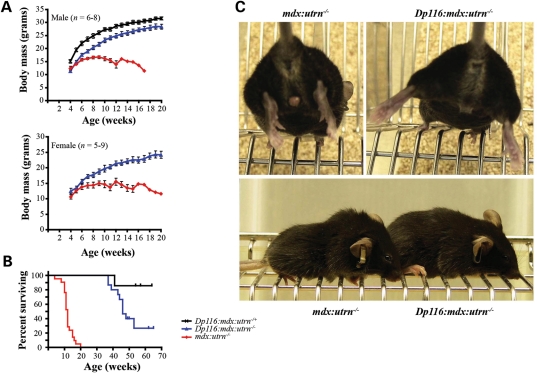Figure 2.
Expression of Dp116 increases viability of mdx:utrn−/− mice. (A) Both male and female transgenic Dp116:mdx:utrn−/− mice had continued weight gain after 10 weeks of age, while the control mdx:utrn−/− mice displayed a failure to thrive beyond 10 weeks of age. However, the transgenic Dp116:mdx:utrn−/− mice were consistently smaller than transgenic mice with one functional utrophin allele. Error bars signify ±SEM and are not shown for time points where only one surviving mouse remained in the cohort. (B) Expression of Dp116 increased lifespan of mdx:utrn−/− mice. Kaplan–Meier analysis demonstrated a significant increase in survival (P < 0.0001) of Dp116:mdx:utrn−/− mice (n = 15, 5 females, 10 males) compared with control mdx:utrn−/− mice (n = 21, 14 females, 7 males). Each tick-mark in the transgenic cohort indicates the age of a surviving mouse at the end of this study. (C) An 11-week-old mdx:utrn−/− male is shown to demonstrate joint contractures of the hind limbs (upper left). The Dp116:mdx:utrn−/− male littermate does not suffer from joint contractures and is able to extend its hind limbs (upper right). The same littermates are shown in the lower panel to demonstrate that spinal kyphosis and reduced musculature in the mdx:utrn−/− control (left) are absent in the Dp116 transgenic littermate (right).

